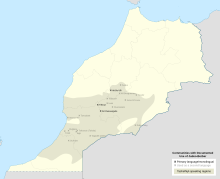lingvo.wikisort.org - Language
Judeo-Berber or Judeo-Amazigh (Berber languages: ⵜⴰⵎⴰⵣⵉⵖⵜ ⵏ ⵡⵓⴷⴰⵢⵏ tamazight n wudayen, Hebrew: ברברית יהודית berberit yehudit) is any of several hybrid Berber varieties traditionally spoken as a second language in Berber Jewish communities of central and southern Morocco, and perhaps earlier in Algeria. Judeo-Berber is (or was) a contact language; the first language of speakers was Judeo-Arabic.[1] (There were also Jews who spoke Berber as their first language, but not a distinct Jewish variety.)[1] Speakers emigrated to Israel in the 1950s and 1960s. While mutually comprehensible with the Tamazight spoken by most inhabitants of the area (Galand-Pernet et al. 1970:14), these varieties are distinguished by the use of Hebrew loanwords and the pronunciation of š as s (as in many Jewish Moroccan Arabic dialects).
| Judeo-Berber | |
|---|---|
| Region | Israel |
Native speakers | (none[1] L2 speakers: 2,000 cited 1992)[2] |
Language family | Afro-Asiatic
|
Writing system | Hebrew alphabet (generally not written) |
| Language codes | |
| ISO 639-3 | jbe |
| Glottolog | (insufficiently attested or not a distinct language)jude1262 |
 Map of Judeo Berber speaking communities in the first half of the 20th century | |
Speaker population
According to a 1936 survey, approximately 145,700 of Morocco's 161,000 Jews spoke a variety of Berber, 25,000 of whom were reportedly monolingual in the language.[3]
Geographic distribution
Communities where Jews in Morocco spoke Judeo-Berber included : Tinghir, Ouijjane, Asaka, Imini, Draa valley, Demnate and Ait Bou Oulli in the Tamazight-speaking Middle Atlas and High Atlas and Oufrane, Tiznit and Illigh in the Tashelhiyt-speaking Souss valley (Galand-Pernet et al. 1970:2). Jews were living among tribal Berbers, often in the same villages and practiced old tribal Berber protection relationships.
Almost all speakers of Judeo-Berber left Morocco in the years following its independence, and their children have mainly grown up speaking other languages. In 1992, about 2,000 speakers remained, mainly in Israel; all are at least bilingual in Judeo-Arabic.
Phonology
Judeo-Berber is characterized by the following phonetic phenomena:[1]
- Centralized pronunciation of /i u/ as [ɨ ʉ]
- Neutralization of the distinction between /s ʃ/, especially among monolingual speakers
- Delabialization of labialized velars (/kʷ gʷ xʷ ɣʷ/), e.g. nəkkʷni/nukkni > nəkkni 'us, we'
- Insertion of epenthetic [ə] to break up consonant clusters
- Frequent diphthong insertion, as in Judeo-Arabic
- Some varieties have q > kʲ and dˤ > tˤ, as in the local Arabic dialects
- In the eastern Sous Valley region, /l/ > [n] in both Judeo-Berber and Arabic
Usage
Apart from its daily use, Judeo-Berber was used for orally explaining religious texts, and only occasionally written, using Hebrew characters; a manuscript Pesah Haggadah written in Judeo-Berber has been reprinted (Galand-Pernet et al. 1970.) A few prayers, like the Benedictions over the Torah, were recited in Berber.[4]
Example
Taken from Galand-Pernet et al. 1970:121 (itself from a manuscript from Tinghir):
- יִכְדַמְן אַיְיִנַגָא יפּרעו גְמַצָר. יִשוֹפִגַג רבי נּג דְיְנָג שוֹפוֹש נִדְרע שוֹפוֹש יִכיווֹאַנ
- ixəddamn ay n-ga i pərʿu g° maṣər. i-ss-ufġ aġ əṛbbi ənnəġ dinnaġ s ufus ən ddrʿ, s ufus ikuwan.
- Rough word-for-word translation: servants what we-were for Pharaoh in Egypt. he-cause-leave us God our there with arm of might, with arm strong.
- Servants of Pharaoh is what we were in Egypt. Our God brought us out thence with a mighty arm, with a strong arm.
See also
- Judeo-Arabic languages
- Judeo-Moroccan
- Berber Jews
References
- Chetrit (2016) "Jewish Berber", in Kahn & Rubin (eds.) Handbook of Jewish Languages, Brill
- Judeo-Berber at Ethnologue (18th ed., 2015) (subscription required)
- Abramson, Glenda (2018-10-24). Sites of Jewish Memory: Jews in and From Islamic Lands. Routledge. ISBN 978-1-317-75160-1.
- "Jews and Berbers" (PDF). Archived from the original (PDF) on 2008-12-19. (72.8 KB)
Bibliography
- P. Galand-Pernet & Haim Zafrani. Une version berbère de la Haggadah de Pesaḥ: Texte de Tinrhir du Todrha (Maroc). Compress rendus du G.L.E.C.S. Supplement I. 1970. (in French)
- Joseph Chetrit. "Jewish Berber," Handbook of Jewish Languages, ed. Lily Kahn & Aaron D. Rubin. Leiden: Brill. 2016. Pages 118–129.
External links
- Judeo-Berber, by Haim Zafrani (in French)
- Except from Haggadah
На других языках
[de] Judäo-berberische Sprache
Das Judäo-Berberische (Zentralatlas-Tamazight ⵜⴰⵎⴰⵣⵉⵖⵜ ⵜⵓⴷⴰⵢⵜ .mw-parser-output .Latn{font-family:"Akzidenz Grotesk","Arial","Avant Garde Gothic","Calibri","Futura","Geneva","Gill Sans","Helvetica","Lucida Grande","Lucida Sans Unicode","Lucida Grande","Stone Sans","Tahoma","Trebuchet","Univers","Verdana"}Tamaziɣt tudayt) ist eine Berbersprache, die heute nur noch von circa 2.000 Menschen gesprochen wird, hauptsächlich von Juden berberisch-marokkanischer Abstammung, die in Israel leben.- [en] Judeo-Berber language
[it] Lingua giudeo-berbera
La lingua giudeo-berbera è una varietà di lingua berbera parlata storicamente in Marocco dalla comunità ebrea berbera nei monti dell'Atlante. Gran parte delle comunità ebree berbere erano arabofone e ricorrevano al giudeo-berbero per le comunicazioni esterne.[1] La stragrande maggioranza di queste comunità è emigrata in Israele nel corso degli anni '50 e '60 del XX secolo. I dialetti giudeo-berberi presentavano un'avanzata mutua intelligibilità con i dialetti parlati dai berberi musulmani della zona,[2] caratterizzandosi per una profonda influenza lessicale della lingua ebraica e per la pronuncia del fonema /š/ come /s/ (similmente a molti dei dialetti giudeo-arabi).[ru] Еврейско-берберские диалекты
Еврейско-берберские диалекты (Judeo-Berber) — собирательное название вариантов разных берберских языков, используемых (или использовавшихся) т. н. берберскими евреями, жившими среди берберов. Как правило, отличаются от соответствующих языков только использованием еврейского письма и некоторыми заимствованиями из древнееврейского. Одной из особенностей местных евреев (как бербероязычных, так арабоязычных) является произношение [s] вместо [š].Другой контент может иметь иную лицензию. Перед использованием материалов сайта WikiSort.org внимательно изучите правила лицензирования конкретных элементов наполнения сайта.
WikiSort.org - проект по пересортировке и дополнению контента Википедии